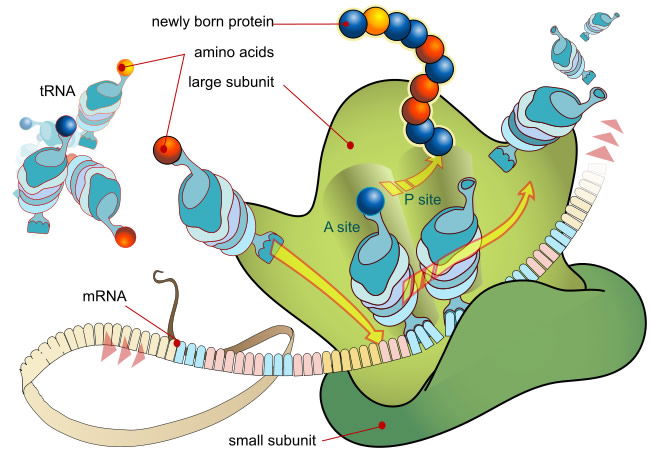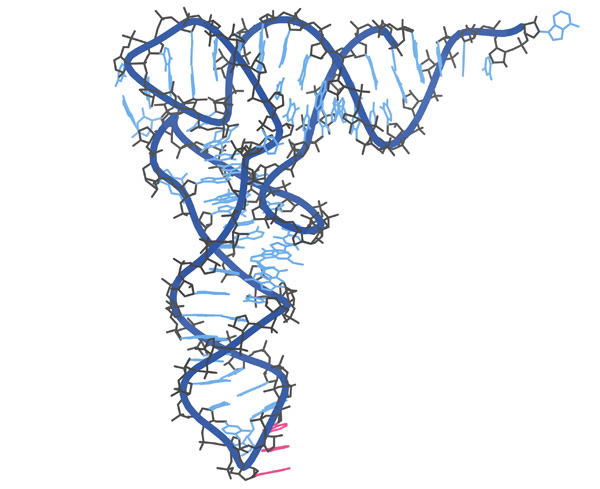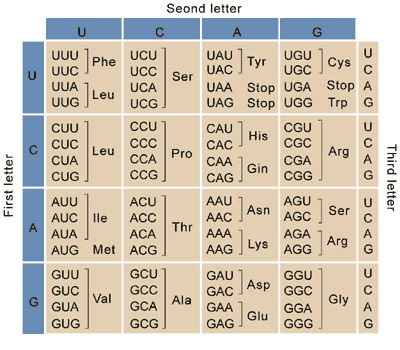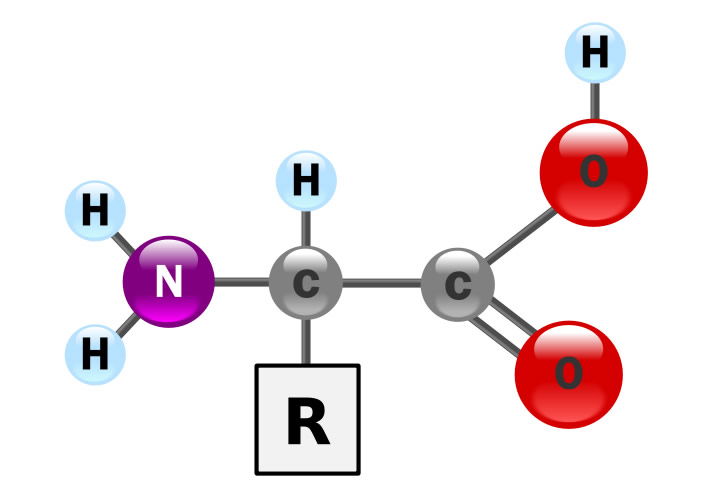
Is a Limited Genetic Code Proof That God Is Not Required?
When I was taking my first General Chemistry class as an undergraduate at The Ohio State University, I never realized that my professor was the codiscoverer of the 21st amino acid. Amino acids are the individual building blocks that make up proteins. Each amino acid is important in making the right protein because one amino acid change can lead to diseases like sickle-cell anemia. While there are myriad amino acids, the standard genetic code found in living things only incorporates 20 of those amino acids. Discovery of the 21st amino acid (called selenocysteine) was significant because of the possibility to elucidate new protein combinations. Since discovery of the 21st amino acid (along with the 22nd amino acid pyrrolysine), we now know not all organisms incorporate these extra amino acids and some only rarely do so. The genetic code is very important because it turns the information in our DNA into proteins that do all the work in every single cell. If the genetic code is altered significantly, then life cannot exist.
What Is the Genetic Code?
Evolutionists frequently cite the genetic code’s universality as proof of evolution from a common ancestor. The genetic code is the series of nucleotides that encode for a particular amino acid. Nucleotides are the Adenine, Cytosine, Guanosine, and Thymine (ACGT) present in your DNA. During a process called transcription, the information from DNA is synthesized into RNA. When transcription occurs, all Thymines in DNA are replaced with Uracils in RNA. It is difficult to say exactly how many different kinds of RNA molecules exist,1 but the three forms of RNA important for the production of proteins from genes are messenger RNA (mRNA), ribosomal RNA (rRNA), and transfer RNA (tRNA).

Image by Dovelike, via Wikimedia Commons.
mRNA is synthesized to carry the message in our genes (parts of our DNA that encode instructions for proteins) to the place where proteins are made, called the ribosome. When a gene is switched on, an enzyme called RNA polymerase synthesizes an mRNA transcript from the gene that eventually is turned into protein at the ribosome. Ribosomes are made almost entirely of rRNAs. rRNAs come from special genes with unique functions. rRNAs are only used in making the scaffold of the ribosome or to catalyze chemical reactions in the ribosome (like peptide bond formation which connects the amino acids together to make the protein). The last molecule involved in making a protein from mRNA is the tRNA molecule. tRNAs were originally predicted by the codiscoverer of the DNA double helix, Francis Crick. One end of the tRNA base pairs with the mRNA (called the anticodon in tRNA) while the other end is charged with the corresponding amino acid.2 mRNA molecules are read three letters at a time in what are called codons. These codons are the three letters that make up the genetic code and each encodes for a specific amino acid.

mRNA Translation. Image by LadyofHats, via Wikimedia Commons.

tRNA with the three anticodon bases highlighted in pink. Image by Dcrjsr, via Wikimedia Commons.

Image by CFCF, via Wikimedia Commons.

Image by GifTagger, via Wikimedia Commons.
The genetic code was originally identified once these major types of RNAs were discovered. To crack the code, molecular biologists synthesized a string of U’s and found that the constructed peptide contained only phenylalanine. Because we knew that the genetic code incorporates the 20 essential amino acids, we knew that the codons of the genetic code must be read three nucleotides at a time.3 Over time, molecular biologists synthesized all possible combinations of the three-letter code from the four nucleotides and were able to crack the code entirely.

Image by Dr. G. R. Kantharaj, Molecular Biology for Masters.
One interesting aspect of the genetic code is that some amino acids have multiple codons. For example, my favorite amino acid with multiple codons is called leucine. There are six different codons for this amino acid, but others only have one codon, like the amino acid methionine. If you look closely at the genetic code, the third position in the codon can often be switched without changing the amino acid significantly and still have a functional protein. Technically, changing the third position (aka wobble position) can change the amino acid, but the changes in the wobble position often code for an amino acid with very similar biochemistry. Major differences occur when the second position changes because those mutations often radically change the amino acid and, thus, affect the biochemistry of the protein. Sometimes, those mutations introduce what’s called a stop codon. Stop codons do not carry an amino acid and are how the ribosome knows to stop making a protein. When a ribosome sees a stop codon, it falls apart because there is no tRNA carrying an amino acid—most of the time.
“Extra” Amino Acids
Even though life is overwhelmingly composed of the 20 amino acids, there are actually many different kinds of amino acids, well beyond the standard set of 20. Some of these “extra” amino acids are incorporated into proteins in our cells and are required for life. Selenocysteine and pyrrolysine are the two nonstandard amino acids and are incorporated into essential proteins, but at an extremely low frequency. While there are additional amino acids, the genetic code remains the same for nearly all of life. But because the genetic code is the same, scientists wondered whether that had any evolutionary significance for the origin of life. To address the uniformity of the genetic code, some molecular biologists have expanded the standard genetic code to incorporate novel amino acids, just to prove that they could. This team of molecular biologists recently introduced a new amino acid in the genetic code, using a novel amino acid from the laboratory to augment the genetic code.4 Not only have scientists successfully manipulated the genetic code, but there are also reports of incorporating nonnatural nucleotides besides the standard A, C, G, and T.5 Further magnifying the complexity of life, E. coli has 41 different tRNA genes for the 64 codons, and that sufficiently produces the 20 amino acids (i.e., 20 amino acids is less than the 64 possible codons).6 While there is an abundance of tRNA genes compared to the number of amino acids, the problem with fewer tRNA genes than the number of codons in the genetic code is something called redundancy built into the genetic code. The primary issue with the evolutionary model to explain the redundancy of the genetic code is that no selective pressure exists to clearly demonstrate how multiple copies of nearly identical genes can exist. Furthermore, evolution cannot randomly put together the nonrandom (and precise) code present in all of life. We are not blindly claiming that God created everything, but we are claiming that God created everything because we know that random processes never lead to order. Intelligence is required to provide not just the parts but the precise pairing as well. If some group of scientists has to tinker with God’s original creation, they are not actually working with a random-chance combination of a genetic code appearing from nothing. Any evolutionist who makes a serious claim of expanding the genetic code needs to work in a universe that does not have any genetic code to start with. Having a genetic code in the first place is part of God’s creation, and man is just working with part of what has already been made. There remains no new information provided. The fact that there is a core set of amino acids with a few additional is not sufficient proof that evolution happened, is happening, or ever will happen. These scientists have proven that we live in a world created by God as stated in Genesis.
Language Implies a Mind
The design of the genetic code is amazing, because all apparent molecular shortcomings (e.g., codon redundancy) are accounted for by additional cellular machinery. At the cellular level, there are protein complexes that exhibit such exquisite levels of design that they look like literal machines (the best example of a molecular machine is the bacterial flagella that looks like an outboard motor on a boat). Evolution of one molecular machine is impossible enough, let alone trying to believe that multiple molecular machines simultaneously evolved entirely correct at the exact same time or else you die. The number of tRNA genes present in any given organism are always in abundance rather than only the copies needed for life. Even though there are multiple copies of the tRNA genes, the cell knows how to control each and every one of them using molecular machines to do what they’re supposed to do. Evolutionists look at these molecular machines and just suppose that they evolved randomly to match everything perfectly. Rather than assume they match perfectly by accident, why not realize that these molecular machines were actually designed? Not only are the aminoacyl transferases designed to match the correct tRNAs with the correct codon and corresponding amino acid, but even the entire idea of the wobble position is
also clear evidence of design.7 There is a concept within biblical creation that the presence of the wobble position demonstrates that God saw the Fall because of His omniscience (aka front loading) and overdesigned the genetic code. Redundancy in the genetic code protects us from harmful mutations that lead to diseases such as cancer.8 I remember talking about the genetic code while in graduate school and was amazed that no one pointed out that a programmed code has a Programmer. Evolutionists are so bent on apparent design that they miss the actual design before their eyes (John 3:19; Romans 1:28).
The design of the genetic code is further demonstrated in how molecular biologists abbreviate the amino acids. Each amino acid is abbreviated initially by a three-letter code and then a one-letter code. Since there are 20 amino acids, there are twenty single letters used to abbreviate each amino acid. Even though the English alphabet has 26 letters in it, 20 letters for the 20 amino acids is not far from some other alphabets.9 Thinking about the genetic code as an alphabet means that it has the complexity of a language, which strongly points to design. The similarity between the genetic code and spoken language has not gone unnoticed when discussing origins.10 Furthermore, the genetic code is more advanced than any known computer code because all computers are based on a binary code of 0s and 1s while the genetic code is quaternary (As, Cs, Gs, and Ts). If we know a tornado didn’t go through the landfill in Silicon Valley back in the 1970s to produce the first Apple computer, then evolutionists must reevaluate their faith in random chance building life based on a quaternary code. A quaternary code is far more complex than a binary code, and an entire language with grammar and syntax is associated with DNA. If we know that computers were designed in a relatively short amount of time by human intelligence, then it is even more important to recognize that every living thing must be significantly more designed than any computer. Furthermore, the origin of the genetic code (for as complex as it is) must also be recent and not ancient because it took humanity close to 6,000 years to build the first computer. If it took humans 6,000 years to build a computer using 0s and 1s, there is no way for random chance processes to produce any kind of life even over 11 billion years using As, Cs, Gs, and Ts; so it is beyond logical that an infinite God miraculously spoke everything into existence over six days. Life is not a random chance accident, but the expression of a mind with intelligence: our Creator God.
It is impossible to prove nothing did it.
A quick search of the Internet calls this genetic complexity problem by a variety of names. The problem of how complex our genetics are is something that even evolutionists ponder and discuss. With all the possible ways to produce language and, by extension, sequences of DNA, the problem is that there is no known random mechanism possible to create this information. Information always has a Source, unless you’re a blind evolutionist believing wildly in random chance. While I was taking biochemistry, I had one version of the comparison as follows:

Image by Quibik, via Wikimedia Commons.
It has been said that an army of dedicated monkeys, typing at random, would eventually produce all of Shakespeare’s works. How long, on average, would it take 1 million monkeys, each typing on a 46-key typewriter (space included but no shift key) at the rate of 1 keystroke per second, to type the phrase “to be or not to be”?11
Without directly giving away how to solve this exact problem for future biochemistry students, the answer to this version of the question is that it would take 1.35 x 1016 years for the monkeys to accomplish this feat.12 But the practical issue with this answer is that the age of the universe is ~1.4 x 1010 years. The actual age of the universe (including the big bang and all of biological evolution) is not even a fraction of a percentage of the time it would take for this army of monkeys to type even this simple phrase. There is not enough time for just this simple phrase, even if a computer was used to direct the correct answer.13 If a computer program is used (as has been done by Richard Dawkins), then this would actually be accomplished because of the computer programmer and not the computer in and of itself. Claiming that a computer can solve evolutionary algorithms is like blaming car keys for vehicle accidents. No sane person blames car keys, but everyone (including the court of law) blames the driver behind the wheel and not just a part of the complex scenario.
Chance-of-the-Gaps
Creationists are often accused of believing in a god-of-the-gaps that requires God’s presence to perform miracles X, Y, and Z.14 Some creationists should be blamed for making a god-of-the-gaps argument because there are often times when there is a reasonable explanation that does not require exercising blind faith. However, there are reasonable times when God is required to explain when He truly was at work because the alternative god of chance is unreasonable (e.g., when Jesus turned water to wine at the wedding in Cana of Galilee in John 2). Evolutionists will argue vehemently that evolution is true because there still is a chance that it could have happened. Chances are actually in favor of evolution not being true because it cannot overcome the odds. The irony of this scenario is that a recent study even tried to explain why there are only 20 amino acids and 64 codons.15 Evolutionists want a limit to the genetic code because the odds are already impossible for evolution; having even more possible combinations in the genetic code exacerbates miracle upon miracle.
Placing a limit on the genetic code cannot rule out God’s existence. Finding limits to the genetic code is a confirmed prediction borne from Scripture because everything reproduces after its “kind” (Genesis 1:11). If our inference from Scripture is right that everything is supposed to reproduce “after its kind,” then there are boundaries in place from the created kinds that God made. As a result, there is no opportunity for additional forms of life to evolve while simultaneously allowing for a reasonable amount of variation at the species level. A limited genetic code highlights that all living things have boundaries, which is stated clearly in Genesis. Furthermore, those claiming to know why the genetic code is limited also imply that they know of the natural selection molecular mechanism that produced the genetic code in the first place. They neither offer an origin of the genetic code nor rule out biblical creation. In fact, the universality of the genetic code points to a common Designer—not common ancestry.
Footnotes
- The number of RNA molecules that exist continue to grow almost one per year. The most recent type of RNA molecule discovered was the long, noncoding RNAs (lncRNAs). We still don't completely know what these do.
- It is stunning how precise the process is to charge the tRNA with the correct amino acid. Enzymes called aminoacyl transferases are specialized enzymes that somehow know to put the correct amino acid onto the correct tRNA molecule. This is such an amazing process because the only places within the tRNA molecule that appear to be different are located in the anticodon region and the aminoacyl transferases are not large enough to physically reach those anticodons. While there likely is a natural explanation for how this happens, it is only supernatural that the process exists in the first place because there is no selective mechanism at this molecular level.
- To determine the possible combinations of the four nucleotides that make up a codon, we can use the equation 4n where the number 4 represents the four possible nucleotides and the letter n represents the number of nucleotides in a codon. If the genetic code was read one letter at a time and there are four letters to DNA, then the possibility would be 41 = 4 possible codons. If two letters, then 42 = 16. The only way to have enough combinations for all the amino acids would be to read codons of three, which is 43 = 64. Indeed, there are 64 codons in the genetic code.
- Lei Want et al., “Expanding the Genetic Code of Escherichia coli,” Science 292, no. 5516 (April 2001): 498–500.
- Ichiro Hirao et al., “An Unnatural Base Pair for Incorporating Amino Acid Analogs into Proteins,” Nature Biotechnology 20 (2002): 177–182.
- Jean Solomovici, Thierry Lesnik, Claude Reiss, “Does Escherichia coli Optimize the Economics of the Translation Process?,” Journal of Theoretical Biology 185, no. 4 (April 1997): 511–21, 512.
- The added layers of complexity also include that the wobble position is actually associated with having an importance in regulating protein translation. See Michael Stadler and Andrew Fire, “Wobble Base-Pairing Slows in Vivo Translation Elongation in Metazoans,” RNA 17, no. 12 (2011): 2063–2073, doi:10.1261/rna.02890211. So all 64 codons have an actual function. In addition to that, a recent publication found that DNA has a genetic code on top of a genetic code. This additional genetic code is known as a second code. See the following article here: doi:10.1126/science.1243490.
- Since there is evidence of cancer in the fossil record, we know that cancer must have been around by the time of the Flood. Cancer is a disease caused at the molecular level where there is an accumulation of mutations. But the presence of proofreading enzymes is additional support for the idea that God’s foreknowledge of mutations creeping into our DNA would cause Him to provide a solution. Gaining mutations in our genome is the subject of the book Genetic Entropy by John Sanford.
- Hebrew has 22 letters with no vowels. The fact that the genetic code has 20 letters including vowels means that there is a semantic range comparable to the Hebrew language.
- My biochemistry professor began his first lecture by saying that the evolution of language is a lot like evolution of DNA and life in general. Though he was an evolutionist, I couldn’t help but think that his observation was entirely correct that DNA evolution is limited to the same extent that language evolution is. The languages all can be traced to one prototypic language that dates back to the Tower of Babel. So, too, do all current mutations trace back to the dispersion and the Tower of Babel. Though mutations have occurred since, a genetic bottleneck goes to the Tower of Babel and so do the languages. If you study the parts of the world that the ancient languages went to after the Tower of Babel, it corresponds to the origins of the modern language groups. Just as we all go back to Noah with our genetics, we also go back to Noah with our language (which dispersed at Babel). We don’t know what mutations entered our DNA between Adam and Noah or between Noah and the tower of Babel. But we know that we are all descendants from Adam and Noah, so we must also obtain our mutations from how the ethnic groups dispersed at Babel. The same is true of the languages and their dispersal with language variants.
- Donald Voet and Judith G. Voet eds., Biochemistry, 2nd ed. (John Wiley & Sons, 1995), 20.
- The way to calculate the answer to this problem is (46)18, and there are 46 keys on the keyboard with only one possible combination for an 18-character phrase. The estimate would be to get to the phrase correct halfway through. With one million monkeys, the math would look as follows: (4618)/(2 x 106) = 4.25 x 1023 s = 1.35 x 1016 years.
- The known age of the universe is 0.00000000000001% the amount of time required for a fully developed army of dedicated (immortal) monkeys to type the phrase “to be or not to be.” Those are extremely low odds.
- Another way to think of what god-of-the-gaps is to think of it like taking a blind step of faith when there are reasonable steps available. It is similar to getting the answer “because I said so” when your parents tell you to do something without having a reason for their command. Parents should always have reasons for asking their children to obey, and should not be dictators that are running the parent show (which is equally as wrong as making a god-of-the-gaps argument).
- Adelaide Saint-Leger et al., “Saturation of Recognition Elements Blocks Evolution of New tRNA Identities,” Science Advances 2, no. 4 (2016): doi:10.1126/sciadv.1501860.
Recommended Resources

Answers in Genesis is an apologetics ministry, dedicated to helping Christians defend their faith and proclaim the good news of Jesus Christ.
- Customer Service 800.778.3390
- © 2024 Answers in Genesis





